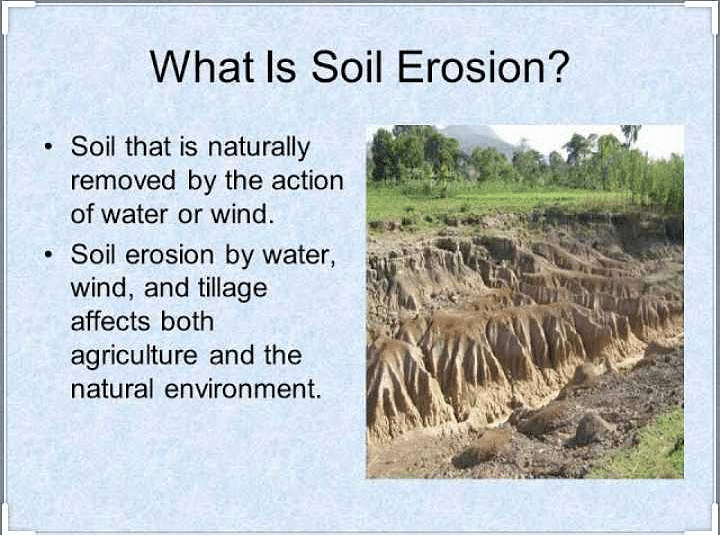Class 7 Exam > Class 7 Questions > Explain soil erosion with diagram and label?
Start Learning for Free
Explain soil erosion with diagram and label?
Most Upvoted Answer
Explain soil erosion with diagram and label?
Soil erosion is the process of wearing away or removal of topsoil by natural agents such as water, wind, ice, and gravity. It is a serious environmental problem that results in the loss of fertile land, decreased agricultural productivity, and damage to natural ecosystems. Here is a diagram and label of soil erosion:

**Explanation of the Diagram and Labels:**
1. **Topsoil:** This is the uppermost layer of soil that is rich in nutrients and organic matter. It is the layer of soil that is most vulnerable to erosion.
2. **Erosion:** This refers to the process of wearing away or removal of topsoil by natural agents such as water, wind, ice, and gravity.
3. **Rain:** Rain is one of the main agents of soil erosion. It can cause the topsoil to become loose and easily carried away by water.
4. **Runoff:** Runoff is the water that flows over the surface of the soil. It can carry away the topsoil and deposit it elsewhere.
5. **Gully Erosion:** Gully erosion occurs when water flows over the surface of the soil and creates deep channels or gullies. These gullies can become wider and deeper over time, causing further soil erosion.
6. **Sheet Erosion:** Sheet erosion occurs when water flows over the surface of the soil and removes thin layers of topsoil. This can lead to the loss of nutrients and decreased agricultural productivity.
7. **Wind:** Wind is another main agent of soil erosion. It can cause the topsoil to become loose and easily carried away.
8. **Deposition:** Deposition occurs when the eroded soil is deposited in another location. This can lead to the loss of fertile land in one area and the accumulation of sediment in another.
9. **Prevention:** Prevention of soil erosion involves practices such as planting vegetation, building terraces, and creating buffer zones. These practices can help to reduce the impact of natural agents such as water and wind on the soil.

**Explanation of the Diagram and Labels:**
1. **Topsoil:** This is the uppermost layer of soil that is rich in nutrients and organic matter. It is the layer of soil that is most vulnerable to erosion.
2. **Erosion:** This refers to the process of wearing away or removal of topsoil by natural agents such as water, wind, ice, and gravity.
3. **Rain:** Rain is one of the main agents of soil erosion. It can cause the topsoil to become loose and easily carried away by water.
4. **Runoff:** Runoff is the water that flows over the surface of the soil. It can carry away the topsoil and deposit it elsewhere.
5. **Gully Erosion:** Gully erosion occurs when water flows over the surface of the soil and creates deep channels or gullies. These gullies can become wider and deeper over time, causing further soil erosion.
6. **Sheet Erosion:** Sheet erosion occurs when water flows over the surface of the soil and removes thin layers of topsoil. This can lead to the loss of nutrients and decreased agricultural productivity.
7. **Wind:** Wind is another main agent of soil erosion. It can cause the topsoil to become loose and easily carried away.
8. **Deposition:** Deposition occurs when the eroded soil is deposited in another location. This can lead to the loss of fertile land in one area and the accumulation of sediment in another.
9. **Prevention:** Prevention of soil erosion involves practices such as planting vegetation, building terraces, and creating buffer zones. These practices can help to reduce the impact of natural agents such as water and wind on the soil.
Community Answer
Explain soil erosion with diagram and label?

Attention Class 7 Students!
To make sure you are not studying endlessly, EduRev has designed Class 7 study material, with Structured Courses, Videos, & Test Series. Plus get personalized analysis, doubt solving and improvement plans to achieve a great score in Class 7.

|
Explore Courses for Class 7 exam
|

|
Explain soil erosion with diagram and label?
Question Description
Explain soil erosion with diagram and label? for Class 7 2024 is part of Class 7 preparation. The Question and answers have been prepared according to the Class 7 exam syllabus. Information about Explain soil erosion with diagram and label? covers all topics & solutions for Class 7 2024 Exam. Find important definitions, questions, meanings, examples, exercises and tests below for Explain soil erosion with diagram and label?.
Explain soil erosion with diagram and label? for Class 7 2024 is part of Class 7 preparation. The Question and answers have been prepared according to the Class 7 exam syllabus. Information about Explain soil erosion with diagram and label? covers all topics & solutions for Class 7 2024 Exam. Find important definitions, questions, meanings, examples, exercises and tests below for Explain soil erosion with diagram and label?.
Solutions for Explain soil erosion with diagram and label? in English & in Hindi are available as part of our courses for Class 7.
Download more important topics, notes, lectures and mock test series for Class 7 Exam by signing up for free.
Here you can find the meaning of Explain soil erosion with diagram and label? defined & explained in the simplest way possible. Besides giving the explanation of
Explain soil erosion with diagram and label?, a detailed solution for Explain soil erosion with diagram and label? has been provided alongside types of Explain soil erosion with diagram and label? theory, EduRev gives you an
ample number of questions to practice Explain soil erosion with diagram and label? tests, examples and also practice Class 7 tests.

|
Explore Courses for Class 7 exam
|

|
Suggested Free Tests
Signup for Free!
Signup to see your scores go up within 7 days! Learn & Practice with 1000+ FREE Notes, Videos & Tests.

























